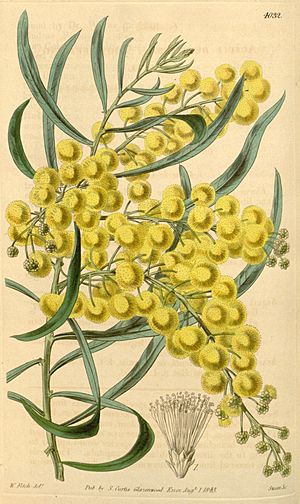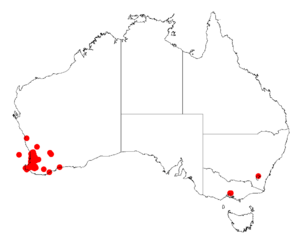Tooth-bearing acacia facts for kids
Quick facts for kids Tooth-bearing acacia |
|
|---|---|
 |
|
| Acacia dentifera illustration | |
| Scientific classification | |
| Genus: |
Acacia
|
| Species: |
dentifera
|
 |
|
| Occurrence data from AVH | |
The Acacia dentifera, also known as the tooth-bearing acacia, is a type of shrub. It belongs to the Acacia plant family. This plant is special because it is found only in the southwestern part of Australia. This means it is endemic to that area.
What is the Tooth-Bearing Acacia?
The tooth-bearing acacia is a shrub that grows upright. It can reach a height of about 0.6 to 3.0 meters (2 to 10 feet). Its branches are smooth and have small brown dots. Older parts of the branches have tiny, tooth-like bumps. These bumps are actually old stipules, which are small leaf-like parts at the base of a leaf stalk.
What Does It Look Like?
The leaves of this acacia are called phyllodes. They are thin and green, shaped like narrow lines or sometimes slightly oval. They can be straight or a little curved. These phyllodes are usually 7 to 15 centimeters (2.8 to 5.9 inches) long and 2 to 5 millimeters (0.08 to 0.2 inches) wide. When they are young, they might have reddish-brown, sticky hairs. Each phyllode has a clear line down the middle.
This plant blooms from August to November. It produces bright yellow flowers. These flowers grow in round or slightly oval clusters. Each cluster can have 30 to 45 golden-colored flowers.
After the flowers, long, round seed pods grow. These pods are red to brown and are a bit squeezed between each seed. They can grow up to 6.5 centimeters (2.6 inches) long and about 4 millimeters (0.16 inches) wide. Inside the pods are shiny, brown seeds. Each seed is about 3.5 to 4.5 millimeters (0.14 to 0.18 inches) long. They have a white aril, which is a fleshy covering.
Where Does It Grow?
The tooth-bearing acacia is found in a specific part of Western Australia. It grows in the eastern suburbs of Perth, in areas like the Darling Range and the Peel and South West regions.
It prefers soils that are gravelly and made from laterite or granite. You can find this plant from Helena Valley in the north down to Bridgetown in the south. It often grows near rivers or streams. You might also see it among granite rocks, as part of Eucalyptus forest communities.

